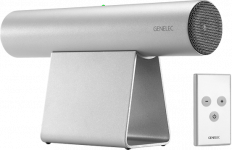Next step for me
...
without even thinking of delays or curvatures.
...
This is done by the relative impedances and efficiencies. Elementary, but it works already pretty well for a new born.
hm.. Jordan-Watts horizontal integrated line array?
is Your evolution towards something like stereo version of this one below?
An externally hosted image should be here but it was not working when we last tested it.
and as I told You many times before - try reflective Paragon-principle
and first of all - as regards the horiznotal array - flood it!
Last edited:
Next step for me and now in topic because it's (almost) from a single loudspeaker following Elias's definition.
Interestingly a "traditional" mapping with L-C-R banks does'nt give as good results than the vertical arrays. But my plan was to try some other combinations, this becoming possible when using many drivers (but I will add more).
Here just a wiring sample between maybe one hundred possible variants, without even thinking of delays or curvatures. Arbitrarily the green an red groups have some optimistic names, but it's close to the reality. This is done by the relative impedances and efficiencies. Elementary, but it works already pretty well for a new born.
Very nice !
I'm thinking about singular point radiator, multiple element.. matrixed..
An externally hosted image should be here but it was not working when we last tested it.
- Elias
He He, Paragon, Flooder...let me dig this one first. One of the difficulties is the mix of problems related to the horizontal array with other problems related to the matrixes. It's happy that the Hf and boomers sections are already optimized.
An example : soon I saw that this layout was producing some double clues. First solution by low passing. Later, much worse, I discovered that some events were shifting to the opposite side, this only caused by the array. More puzzling, when listening separately to each matrix, some events were correct with one matrix but still incorrect with the other one. Eureka ? Not yet, because on some other tests the situation was inversed. The matrix having before a correct localization was now faulty, and the other one totally correct.
Trying an other mapping was no more satisfying. Nothing to do with the DCX...Exasperating.
But acoustic problems have sometimes very simple solutions. Matrix or not, this remains an array, and listening from 6 meters only is not enough. Passed 8 meters, no more clues messup, and as a bonus, the global SQ raises up.
Of course all the classical behavior of the arrays is here as the possibility of being close to the speaker without suffering of a too high sound level. An other very stunning behavior is the way a panned or a centered message is reproduced (I have been swapping the red speakers with the green ones as suggested by CLS) . To make it simple, the outsiders create the center part of the image, with a very strong phantom and without being detectable. The insiders create the events outside of the array. Good experience also when being close while a very slow panning goes from right to left.
This to say that if Elias starts to deal with multiple speakers, strange layouts, and why not multiple matrixes ratios, he will enter in a very interesting field...
An example : soon I saw that this layout was producing some double clues. First solution by low passing. Later, much worse, I discovered that some events were shifting to the opposite side, this only caused by the array. More puzzling, when listening separately to each matrix, some events were correct with one matrix but still incorrect with the other one. Eureka ? Not yet, because on some other tests the situation was inversed. The matrix having before a correct localization was now faulty, and the other one totally correct.
Trying an other mapping was no more satisfying. Nothing to do with the DCX...Exasperating.
But acoustic problems have sometimes very simple solutions. Matrix or not, this remains an array, and listening from 6 meters only is not enough. Passed 8 meters, no more clues messup, and as a bonus, the global SQ raises up.
Of course all the classical behavior of the arrays is here as the possibility of being close to the speaker without suffering of a too high sound level. An other very stunning behavior is the way a panned or a centered message is reproduced (I have been swapping the red speakers with the green ones as suggested by CLS) . To make it simple, the outsiders create the center part of the image, with a very strong phantom and without being detectable. The insiders create the events outside of the array. Good experience also when being close while a very slow panning goes from right to left.
This to say that if Elias starts to deal with multiple speakers, strange layouts, and why not multiple matrixes ratios, he will enter in a very interesting field...
Last edited:
He He, Paragon, Flooder...let me dig this one first. One of the difficulties is the mix of problems related to the horizontal array with other problems related to the matrixes. ...
wait wait! I mean just Paragon-like parabolic reflector
and regarding the flooding the horizontal array - when You have such big dedicated room then wouldn't having speakers just on the floor - in any arrangement You like - be much more practical for experimenting than suspending them from the ceiling?
Seems there is a new name in the game of single speaker stereo !
I touched these in a local store. In the back there was DC plug and USB connector.
Genelec 6000A-Tube
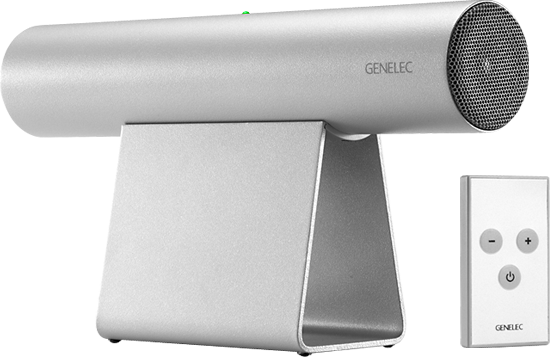
I touched these in a local store. In the back there was DC plug and USB connector.
Genelec 6000A-Tube

Attachments
Last edited:
Seems there is a new name in the game of single speaker stereo !
I touched these in a local store. In the back there was DC plug and USB connector.
Genelec 6000A-Tube

nice, have You got an opportunity to listen to some music through it? Are there any magic filters inside?
There seems to be a way to wire bessel-arrays stereo.
A Paul Kemble web page - speaker bessel arrays.
A Paul Kemble web page - speaker bessel arrays.
The stereo wired Bessel array can indeed be considered as a single stereo speaker. I've done extensive analysis on it some time ago  My conclusion on it is, well lets see
My conclusion on it is, well lets see 
It's best to compare it to standard 60 degrees two speaker stereo triangle.
I simulated 2D free space wavefields with different amplitude panning. The white circle in the center is for head size scale.
Here's 2 m base stereo triangle, full left panned, at 2 kHz:
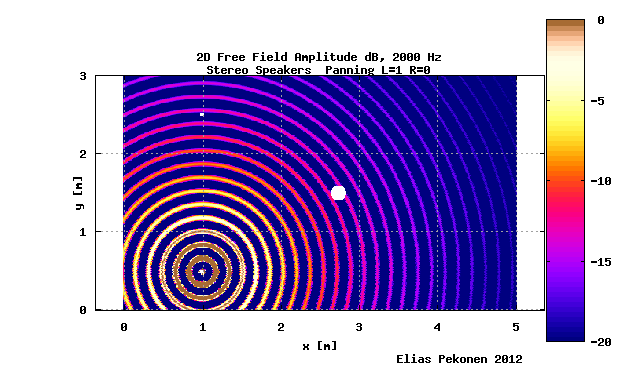
Here's 2 m base stereo triangle, center panned, at 2 kHz:
Severe spatial comb filtering effects. This is how stereo sucks
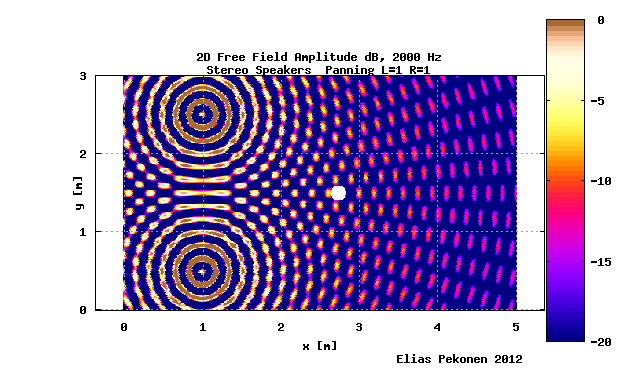
Here's 2 m long ideal stereo bessel array with 101 radiators, full left panned, at 2 kHz:
Heureka ! Ideal Bessel array mimics a point source ! Note that the center of radiation is at the end of the line (perhaps not intuitive).
Note that the center of radiation is at the end of the line (perhaps not intuitive).
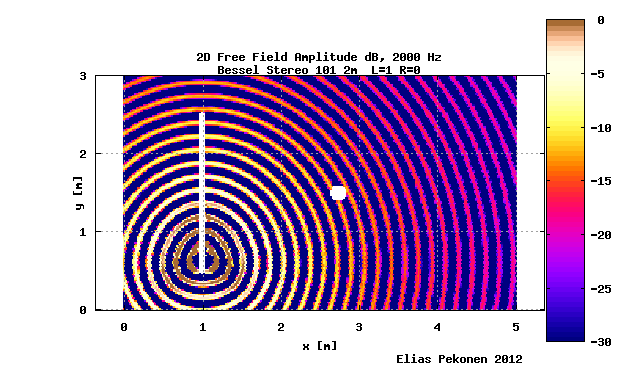
Here's 2 m long ideal stereo bessel array with 101 radiators, center panned, at 2 kHz:
Compare this to 2 speaker stereo triangle.. The same.
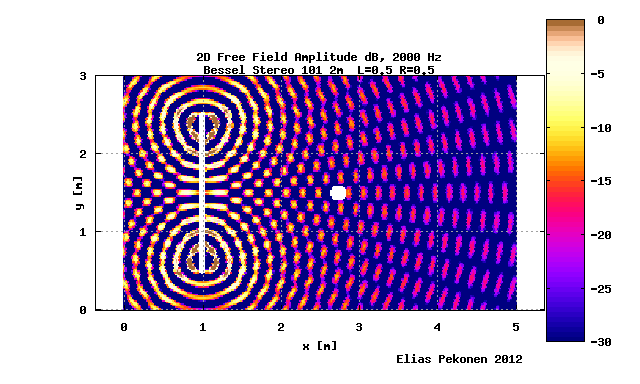
So, what was gained using stereo wired Bessel array ? Cool looking speaker ? Maybe. Anything else ? Perhaps not
- Elias
It's best to compare it to standard 60 degrees two speaker stereo triangle.
I simulated 2D free space wavefields with different amplitude panning. The white circle in the center is for head size scale.
Here's 2 m base stereo triangle, full left panned, at 2 kHz:
Here's 2 m base stereo triangle, center panned, at 2 kHz:
Severe spatial comb filtering effects. This is how stereo sucks
Here's 2 m long ideal stereo bessel array with 101 radiators, full left panned, at 2 kHz:
Heureka ! Ideal Bessel array mimics a point source !
Here's 2 m long ideal stereo bessel array with 101 radiators, center panned, at 2 kHz:
Compare this to 2 speaker stereo triangle.. The same.
So, what was gained using stereo wired Bessel array ? Cool looking speaker ? Maybe. Anything else ? Perhaps not
- Elias
Attachments
-
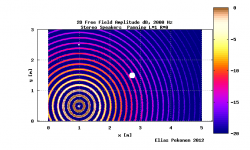 Stereo Speakers_2D Free Field Amplitude dB_2000Hz_L=1_ R=0.png31.4 KB · Views: 424
Stereo Speakers_2D Free Field Amplitude dB_2000Hz_L=1_ R=0.png31.4 KB · Views: 424 -
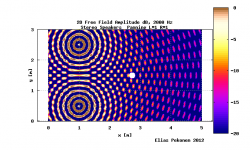 Stereo Speakers_2D Free Field Amplitude dB_2000Hz_L=1_ R=1.png35.6 KB · Views: 436
Stereo Speakers_2D Free Field Amplitude dB_2000Hz_L=1_ R=1.png35.6 KB · Views: 436 -
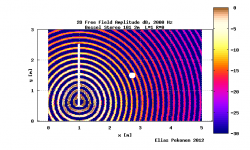 2D vapaakentta_Bessel Stereo 101 2m_2000Hz_L=1_ R=0_Amplitude dB.png26.7 KB · Views: 424
2D vapaakentta_Bessel Stereo 101 2m_2000Hz_L=1_ R=0_Amplitude dB.png26.7 KB · Views: 424 -
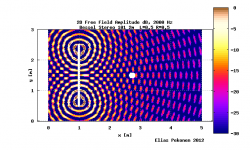 2D vapaakentta_Bessel Stereo 101 2m_2000Hz_L=0.5_ R=0.5_Amplitude dB.png26.3 KB · Views: 419
2D vapaakentta_Bessel Stereo 101 2m_2000Hz_L=0.5_ R=0.5_Amplitude dB.png26.3 KB · Views: 419
I currently dream about coming close to the pulsating sphere with bessel arrays. A cylindric magnetostat with five conductors in bessel-array connection in the center, 36 cylindrically arranged small midrangers forming 6er-arrays with gap (for the tweeter).
Bessel array can indeed be used to mimic a point source.
How is this related to stereo bessel array ? Stereo bessel array works as a stereo source only if it's dimensions are comparable large to a normal stereo triangle. In this case however high frequencies will be very hard due to required small c-c spacing.
In my simulation I used ideal bessel array with 101 radiators. Ideal meaning it follows Bessel functions exactly.
If you take the famous Philips patent and try implementing 5, 7 or 9 element arrays their performance is medicore compared to ideal Bessel function. Well, it's just a patent
- Elias
I tried the Philips patent with 5 drivers ( described by Keele as the only one that makes sense when compared to the 7 or 9 drivers implementations). Far from the ideal because of too big drivers, but in the same conditions, a power shaded wiring with the leading driver in the middle is already far better in the measures ( more linear, better impulse and + 3 dB efficiency). When listening, the Bessel has absolutely nothing better to show.
So, in the configurations I tried, I follow Elias, the Bessel is more a hype than an outstanding thing.
So, in the configurations I tried, I follow Elias, the Bessel is more a hype than an outstanding thing.
How is this related to stereo bessel array ?
No relation, just an OT comment.
BTW,
I still think that you should be able to find speaker concepts where you can't localize the highs.
a power shaded wiring with the leading driver in the middle is already far better in the measures ( more linear, better impulse and + 3 dB efficiency). When listening, the Bessel has absolutely nothing better to show.
Do you know how it is done in the Raidho tweeters?
http://www.raidho.dk/uploads/Raidho-Acoustics-Ribbon-Tweeter-FTT75.pdf
May I ask, without reading through the entire thread again - what was the conclusion with back-to-back dipoles playing the role of the single box with some XT cancellation as a side effect of the rear radiation? The value of 'x' would be determined by absorption/angle of rear waves.
Is the main problem here the efficiency loss of the dipoles?
Is the main problem here the efficiency loss of the dipoles?
I've made some acoustic FDTD simulations of the sound fields of the Single Speaker Stereo SSS in a small room. The room size here is 5*3 m.
The matrix is x = 0.5.
The amplitudes are in dB scale.
Here's an animated propagating wavefront at 1 kHz with center panned stereo signal L=1 and R=1:

Here some snapshots at selected time frames.
The radiation pattern. The maximum radiation is towards the listening area.
The direct sound has passed the listening area and side wall reflections arrive in very high angle relative to the median plane.
- Elias
The matrix is x = 0.5.
The amplitudes are in dB scale.
Here's an animated propagating wavefront at 1 kHz with center panned stereo signal L=1 and R=1:

Here some snapshots at selected time frames.
The radiation pattern. The maximum radiation is towards the listening area.
An externally hosted image should be here but it was not working when we last tested it.
The direct sound has passed the listening area and side wall reflections arrive in very high angle relative to the median plane.
An externally hosted image should be here but it was not working when we last tested it.
- Elias
Last edited:
Here's the sound field of the SSS with matrix x = 0.5 for left panned sound L=1 and R=0.
Animation at 1 kHz:
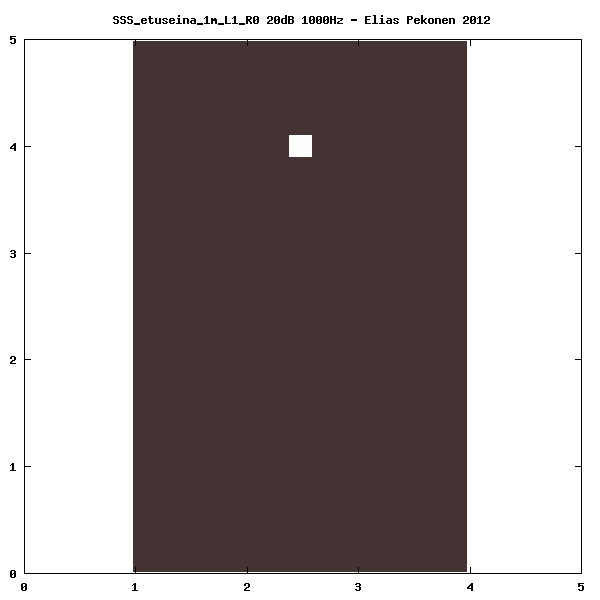
Radiation pattern:
The maximum radiation is towards bottom left, and minimum is towards bottom right.
The side wall reflection passes the listening area. Only the strong left side reflection is present. The reflection from the right side wall is very small, negligible.
The incidence angle of the reflection is very high relative to median plane. This results in low IACC.
- Elias
Animation at 1 kHz:

Radiation pattern:
The maximum radiation is towards bottom left, and minimum is towards bottom right.
An externally hosted image should be here but it was not working when we last tested it.
The side wall reflection passes the listening area. Only the strong left side reflection is present. The reflection from the right side wall is very small, negligible.
The incidence angle of the reflection is very high relative to median plane. This results in low IACC.
An externally hosted image should be here but it was not working when we last tested it.
- Elias
Last edited:
And here's the long story of the FDTD Single Speaker Stereo analysis:
Elias Pekonen Home Page - FDTD simulations on Single Speaker Stereo SSS
- Elias
Elias Pekonen Home Page - FDTD simulations on Single Speaker Stereo SSS
- Elias
And here's the long story of the FDTD Single Speaker Stereo analysis:
Elias Pekonen Home Page - FDTD simulations on Single Speaker Stereo SSS
- Elias
can You post such simulation for a simple stereo bipole with direct sound blocked, without center and matrix?
can You post such simulation for a simple stereo bipole with direct sound blocked, without center and matrix?
I have many plans ! Now that I got the tool, let the fun begin
- Home
- Loudspeakers
- Multi-Way
- Stereophonic Sound from a Single Loudspeaker
